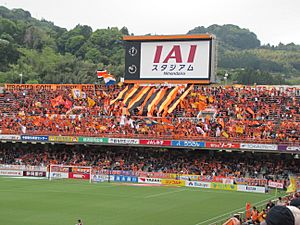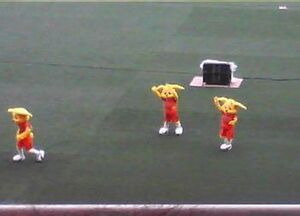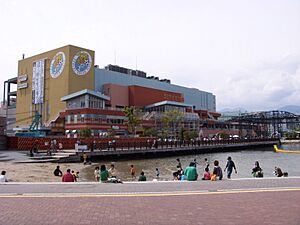Shimizu S-Pulse facts for kids
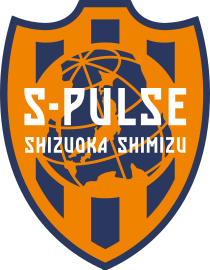 |
|||
| Full name | Shimizu S-Pulse | ||
|---|---|---|---|
| Nickname(s) | S-Pa | ||
| Founded | 1991 | ||
| Ground | IAI Stadium Nihondaira Shimizu, Shizuoka |
||
| Capacity | 19,594 | ||
| Chairman | Shigeo Hidaritomo | ||
| Manager | Tadahiro Akiba | ||
| League | J1 League | ||
| 2024 | J2 League, 1st of 20 (promoted) | ||
|
|
|||
Shimizu S-Pulse (清水エスパルス, Shimizu Esuparusu) is a professional football team from Japan. They are based in Shimizu, Shizuoka, Shizuoka Prefecture. S-Pulse will play in the J1 League for the 2025 season. They earned promotion from the J2 League (Japan's second professional league) in the 2024 season. The club started in 1991 as one of the first ten teams in the J.League. Back then, all their players came from Shizuoka Prefecture, which was quite special.
Even though S-Pulse is younger than many other J1 teams, they have made a big mark on Japanese football. Since football became professional in Japan in 1992, they have been very strong in cup competitions. They have reached ten cup finals: five times in the Emperor's Cup and five times in the League Cup. Only Kashima Antlers, Japan's most successful team, has been in more finals. S-Pulse has won both of these cups once. They also won the Japanese Super Cup twice and the Asian Cup Winners' Cup once. Their most recent cup final was in the 2012 J.League Cup, where they lost to Kashima.
Despite their success in cups, S-Pulse has not yet won the J.League Division 1 title. Their closest chance was in 1999. They won the second part of the league but lost the final title match in a penalty shootout. The score was tied after both games against their local rivals, Júbilo Iwata. Kenta Hasegawa, a former S-Pulse and national team player, became the club's manager in 2005. He was the longest-serving manager until 2010. After he left, Afshin Ghotbi took over for more than three years. The club often moved between J1 and J2 leagues, being promoted and relegated.
Contents
Club History
Shizuoka: A Football Hotspot
Shizuoka Prefecture is known as a "football kingdom" in Japan. It has a long history of strong high school teams and has produced many players for the Japan national football team. The local police even have a football as their mascot! There was already a team from Yamaha Motor Corporation in the west of the prefecture, which later became Júbilo Iwata. But people believed there was room for another team. When the professional league started in the early 1990s, the idea came up to create a team just for local football talent.
How the Club Started
Shimizu S-Pulse began in early 1991 as Shimizu FC. It was supported by local businesses and people. This made them special among the first J.League clubs, as all the others were former company teams that turned professional. Two months later, the club officially changed its name to Shimizu S-Pulse. The "S" stands for Shizuoka, Shimizu, Supporter, and Soccer. "Pulse" means the spirit of everyone who supports the team.
On February 4, 1991, the J.League approved S-Pulse to join the new professional league. The club played its first game against Gamba Osaka on July 4, 1992. This date is now celebrated as the club's birthday. Their first official match was in the 1992 League Cup against Nagoya Grampus on September 5, which they lost 3–2. Their first home game was at Nihondaira Stadium on September 9 against Yokohama Marinos, which S-Pulse won 2–1.
Professional Football Journey
After joining the J.League, S-Pulse played in the first J.League Cup in 1992 and reached the final. However, they lost to Verdy Kawasaki. In 1993, S-Pulse was one of the ten founding members of the new J.League and finished third. They almost won the J.League Cup again, but lost to Verdy Kawasaki in the final. Finally, in 1996, the team won the trophy by beating Verdy 5–4 in a penalty shootout.
In 1999, S-Pulse played in the Japanese Super Cup for the first time. They lost that match 2–1. After playing well in the league, S-Pulse faced their local rivals Júbilo Iwata for the title. The score was tied 3–3 after both games, but S-Pulse lost 4–2 in a penalty shootout. The new millennium brought more success. S-Pulse won the Asian Cup Winners' Cup in 2000 and the Emperor's Cup in 2001. They also won the Japanese Super Cup in 2001 and 2002, meaning they won four cups in three years!
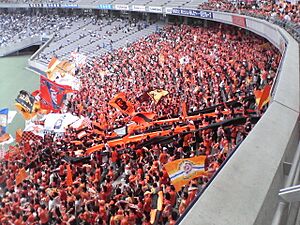
In 2005, S-Pulse reached the Emperor's Cup final without letting in any goals. But they lost the final 2–1 to Urawa Red Diamonds. After almost being relegated, manager Kenta Hasegawa helped the team improve. In 2006 and 2007, S-Pulse finished 4th in the league, and 5th in 2008. However, they didn't win any trophies for five years, their longest dry spell. In 2008, they almost won the League Cup but lost to Oita Trinita.
In 2011, S-Pulse signed Freddie Ljungberg, a famous player from Sweden and Arsenal F.C. Many people in Japan thought this was a huge signing. However, Ljungberg left after about five and a half months and then retired. In the following seasons, S-Pulse had some tough luck.
S-Pulse played four more seasons in J1 until they were relegated in 2015. They started well but then dropped to the bottom three. Fans were very disappointed. After 23 seasons in the top league, they were relegated to J2 for the first time after losing 1–0 at home to Vegalta Sendai on October 17, 2015.
S-Pulse quickly returned to the top league. They secured promotion to the J1 League on the last day of the 2016 J2 League season.
After six years in the J1 League, where they often finished in the lower half of the table, S-Pulse was relegated back to the J2 League in 2022. They finished 17th, just above their rivals Júbilo Iwata.
On October 27, 2024, S-Pulse secured promotion back to the J1 League. They beat Tochigi SC 1–0 with a goal from Jelani Reshaun Sumiyoshi in the 50th minute. This brought them back to the top league after two years away.
Supporters
Like other J.League teams, S-Pulse has many colorful and loud supporters. They follow the team all over the country. A supporter band plays music at games to cheer on the team. The band plays Brazilian-style rhythms and samba sounds. At home games, the loudest S-Pulse fans gather in "The Kop," a stand behind the west goal at Nihondaira Stadium. This is where the organized fan groups are. These groups include fan clubs for specific players and often wear special uniforms. They help organize big displays and support the band.
The club's official fan club has branches across the country. S-Pulse supporters are officially called the team's "twelfth player."
Club Ownership
Suzuyo & Co., Ltd., a large local logistics company, is currently the main owner of S-Pulse. However, S-Pulse started as a "citizen club," meaning it was supported by local people and businesses. In the past, the club sometimes struggled financially. S-Lap Communications, a company funded by Shimizu citizens and Shizuoka Television, originally ran the club. After a difficult period in the late 1990s, Shizuoka Television stopped its support. In 1998, local companies, led by Suzuyo, reorganized the club's ownership. It is now run by a company called S-Pulse, Inc.
S-Pulse in Culture
Even with its fairly short history, S-Pulse has influenced popular culture. Kenta Hasegawa, a former player and current manager, sometimes appears in the popular manga and anime series Chibi Maruko-chan. In the show, there's a boy named Kenta who loves football and is a classmate of the main character. The manga's author, Momoko Sakura, created this character after Hasegawa, as they went to the same primary school. You can even find special S-Pulse Chibi Maruko products. Also, two characters from the popular Captain Tsubasa manga join S-Pulse when they become professional footballers.
Stadiums
Main articles: IAI Stadium Nihondaira, Shizuoka "Ecopa" Stadium, Kusanagi Athletic Stadium
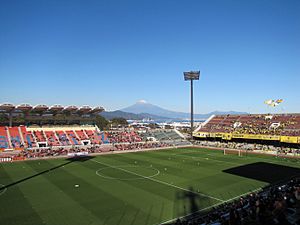
S-Pulse's main home stadium is the Nihondaira Sports Stadium in Shimizu. It can hold 19,594 people. Over the years, S-Pulse has played home games at other stadiums too. In their early years, some "home" games were even played outside Shizuoka Prefecture, like at the National Stadium in Tokyo. Kusanagi Athletic Stadium was also used often, especially when Nihondaira was being expanded or had its pitch replaced.
The main reason for moving games is that Nihondaira Stadium has a limited capacity. Because of this, big games, like those against rival Júbilo Iwata, are often played at Shizuoka "Ecopa" Stadium. This stadium was built in 2001 for the 2002 World Cup and can hold 51,349 people. Even though Ecopa is in Shizuoka Prefecture, it's over an hour away from Shimizu. This means S-Pulse loses some of its home advantage in derby games. In 2007, all home games were played at Nihondaira for the first time since 1999, and this continued in 2008. However, between 2009 and 2015, Ecopa was used for at least one home league game each year. S-Pulse has not used Ecopa since 2015, playing all home league games at Nihondaira.
Stadium Naming Rights
In October 2008, it was announced that the naming rights for Nihondaira Stadium would be sold. In November 2008, a deal was made to rename the stadium Outsourcing Stadium Nihondaira for four years, starting in 2009.
A new five-year sponsorship deal with IAI Corporation, a company that makes industrial robots, began on March 1, 2013. The stadium was renamed IAI Stadium Nihondaira, often shortened to I Sta by the club and fans. This sponsorship deal was extended for another five years in 2018.
Future Plans
In 2008, after filling Nihondaira Stadium to over 81% capacity for league games, the club said they wanted the stadium to be expanded.
In 2020, the club again expressed its hope to build a new, larger home. Different locations have been suggested for a new stadium, including near Higashi-Shizuoka Station and Shimizu Station.
Training Ground
S-Pulse's main training facilities are called Miho Ground. They are located near the famous Miho no Matsubara. Sometimes, training sessions are open to the public for fans to get autographs. The club offices have also been at Miho Ground since the club started.
Rivalries
S-Pulse has a strong rivalry with Júbilo Iwata, another team from Shizuoka Prefecture. This rivalry began when the J.League was formed. S-Pulse was chosen to join the first J.League season, while Júbilo had to earn their way up from a lower league. This has been a point of disagreement between long-time fans.
Shizuoka has long been known as a football homeland in Japan. The two teams often compete to sign the best young players from local high schools and universities. For example, Naohiro Takahara and Takahiro Yamanishi, who went to Shimizu Higashi High School, later signed with Júbilo. Júbilo won three J.League championships between 1997 and 2002.
Besides off-field factors, S-Pulse and Júbilo are always battling for supremacy on the field. In the early days of the J.League, S-Pulse had more success and support. But then, Júbilo became stronger for many years around the turn of the century. More recently, S-Pulse has again become the top club in the area. They have finished above Júbilo in the league every season since 2006 and often have better cup runs. In 2008, S-Pulse also had more fans attend their games than their rivals for the first time since 1995.
Other football clubs in Shizuoka include Fujieda MYFC, Azul Claro Numazu, and Honda FC. Currently, only Fujieda plays at the same level as S-Pulse in the J2 League. This limits rivalries with Azul Claro, who play in J3 League, and Honda FC, who play in the Japan Football League, a level below the J.League. Honda FC has always performed well but has chosen not to become a professional J.League team.
Team Colors, Crest, and Mascot
Colors, Sponsors, and Manufacturers
Since the team started, they have always used the same colors for their home shirts: orange shirts, shorts, and socks. These colors were chosen to represent the famous local product of Shizuoka Prefecture: the mikan (a type of orange citrus fruit). The current bright orange color, called S-Pulse Orange by the club, has slowly become brighter over the years. When the J.League began, S-Pulse was the only top-division club to wear orange. Now, other teams like Albirex Niigata and Omiya Ardija also wear orange. There is currently no third kit. Goalkeeper kit colors have changed more often. The first-choice goalkeeper kit is all black, and the second choice is all green.
Puma has been the kit manufacturer since 1997. Before that, Mizuno Corporation also made their kits. Shirt sponsors have been quite consistent over the team's history. The current main shirt sponsor is the local Suzuyo Group. Other sponsors include confectionery company Glico and Japan Airlines.
| Season(s) | Main Shirt Sponsor | Additional Sponsor(s) | Kit Manufacturer | ||
|---|---|---|---|---|---|
| 1992–1996 | Japan Airlines | Glico | Honen | Mizuno/Puma | |
| 1997–2001 | Puma | ||||
| 2002–2003 | Ajinomoto | ||||
| 2003–2005 | Suzuyo | ||||
| 2005–2006 | Star | The 3rd Planet | |||
| 2006–2007 | Suzuyo | Japan Airlines | |||
| 2007–2008 | CRS | ||||
| 2008– | San-Ai | ||||
Kit Evolution
120th anniversary of the opening of Shimizu port
Club Crest
From the club's start until 1996, S-Pulse used an older version of its team crest. The current crest was revealed for the 1997 season. It was designed around a globe to show the club's goal of being a world-class professional team. The top of the badge looks like Mount Fuji to symbolize that the team represents Shizuoka, where Mount Fuji is located. The blue color, along with the team's orange, represents Shimizu's history as a port town and its closeness to Suruga Bay.
Team Mascot
S-Pulse's mascot is named Palchan. He has big, wing-like ears and entertains fans with dance routines before home games. He often performs with his two younger siblings. Guy Gilchrist, a professional cartoonist, designed Palchan. His name comes from the English word "pal" and the "pul" from S-Pulse. The ending "chan" is a friendly title used in Japan. Palchan wears team number zero, and his merchandise is very popular. S-Pulse also has a cheerleading team called Orange Wave. They perform before games and at other S-Pulse events.
Club Brand and Shops
There are eight official S-Pulse club shops in and around Shizuoka City. Six of these are called S-Pulse Dream House. They sell club merchandise and match tickets. You can find them in Shizuoka, Shimizu, Fujieda, Suntō, and at the Parche shopping center in Shizuoka Station. The Shimizu Dream House also has a screen to show away games. The newest Dream House opened in March 2008 in Fuji City. There are two more S-Pulse shops in Yaizu and at S-Pulse Dream Plaza.
S-Pulse Dream Plaza is a shopping and entertainment complex in Shimizu. It has restaurants, a ferris wheel, a cinema, and a football museum. The S-Pulse Dream Ferry service runs daily from nearby Shimizu Port to Izu. The team also has futsal courts called S-Pulse Dream Fields in Fujieda, Fuji, Sunto, and Shimizu.
Dream Plaza is in a redeveloped part of Shimizu Port, near S-Pulse Street. This street leads into the city from the port and has statues, monuments, and artworks about the city's strong connection to football. These include foot and hand prints of famous former players and several S-Pulse-related statues. The Shimizu Branch of the S-Pulse Dream House is also on S-Pulse Street.
The S-Pulse brand also extends to motorcycle racing. The S-Pulse Dream Racing Team uses the football team's name, logo, and mascot. This team competes in the All Japan Road Race ST600 class.
League and Cup Results
| Champions | Runners-up | Third place | Promoted | Relegated |
| Season | Div. | Teams | Pos. | Attendance/G | J.League Cup | Emperor's Cup | Asia | |
|---|---|---|---|---|---|---|---|---|
| 1992 | Runners-up | Quarter final | ||||||
| 1993 | J1 | 10 | 3rd | 18,462 | Runners-up | Semi-finals | ||
| 1994 | 12 | 4th | 19,726 | 1st round | 1st round | |||
| 1995 | 14 | 9th | 19,747 | 1st round | ||||
| 1996 | 16 | 10th | 12,962 | Winner | Quarter-finals | |||
| 1997 | 17 | 5th | 9,888 | Group stage | Quarter-finals | |||
| 1998 | 18 | 3rd | 12,298 | Semi-final | Runners-up | |||
| 1999 | 16 | 2nd | 12,883 | Quarter-finals | Quarter-finals | |||
| 2000 | 16 | 8th | 12,422 | Quarter-finals | Runners-up | CWC | Winner | |
| 2001 | 16 | 4th | 15,973 | 2nd round | Winner | CWC | 3rd place | |
| 2002 | 16 | 8th | 14,963 | Semi-finals | Quarter-finals | CWC | Quarter-finals | |
| 2003 | 16 | 11th | 16,284 | Semi-finals | Semi-finals | CL | Group stage | |
| 2004 | 16 | 14th | 13,568 | Quarter-finals | 4th round | - | - | |
| 2005 | 18 | 15th | 12,752 | Quarter-finals | Runners-up | |||
| 2006 | 18 | 4th | 14,302 | Group stage | Quarter-finals | |||
| 2007 | 18 | 4th | 15,952 | Group stage | Quarter-finals | |||
| 2008 | 18 | 5th | 16,599 | Runners-up | Quarter-finals | |||
| 2009 | 18 | 7th | 17,935 | Semi-finals | Semi-finals | |||
| 2010 | 18 | 6th | 18,001 | Semi-finals | Runners-up | |||
| 2011 | 18 | 10th | 15,801 | Semi-finals | Quarter-finals | |||
| 2012 | 18 | 9th | 15,121 | Runners-up | 4th round | |||
| 2013 | 18 | 9th | 14,137 | Group stage | 4th round | |||
| 2014 | 18 | 15th | 14,210 | Group stage | Semi-finals | |||
| 2015 | 18 | 17th | 14,083 | Group stage | 2nd round | |||
| 2016 | J2 | 22 | 2nd | 11,274 | Not eligible | Round of 16 | ||
| 2017 | J1 | 18 | 14th | 15,116 | Group stage | Round of 16 | ||
| 2018 | 18 | 8th | 14,671 | Group stage | 3rd round | |||
| 2019 | 18 | 12th | 15,043 | Group stage | Semi-finals | |||
| 2020 † | 18 | 16th | 5,235 | Group stage | Did not qualify | |||
| 2021 † | 20 | 14th | 7,454 | Play-off stage | 4th round | |||
| 2022 | 18 | 17th | 15,256 | Group stage | 3rd round | |||
| 2023 | J2 | 22 | 4th | 14,393 | Group stage | 2nd round | ||
| 2024 | 20 | 1st | 17,750 | 2nd round | 3rd round | |||
| 2025 | J1 | 20 | TBD | 2nd round | TBD | |||
- Key
- Attendance/G = Average home league attendance
- † 2020 & 2021 season's attendances reduced by COVID-19 worldwide pandemic
- Source: J.League Data Site
League History
- Division 1 (J1 League) : 1993–2015
- Division 2 (J2 League) : 2016
- Division 1 (J1 League) : 2017–2022
- Division 2 (J2 League) : 2023–2024
- Division 1 (J1 League) : 2025–
Club Achievements
| Honour | Number of Wins | Years Won |
|---|---|---|
| J2 League | 1 | 2024 |
| Emperor's Cup | 1 | 2001 |
| J.League Cup | 1 | 1996 |
| Japanese Super Cup | 2 | 2001, 2002 |
| Asian Cup Winners' Cup | 1 | 1999–2000 |
Players
Current Squad
|
|
Players on Loan
|
|
Famous Players
Players who have been named Player of the Year or Young Player of the Year in the J.League:
|
|
World Cup Players
Club Officials
For the 2024 season.
| Role | Name |
|---|---|
| Manager | |
| Assistant manager | |
| First-team coach | |
| Goalkeeper coach | |
| Conditioning coach | |
| Analyst | |
| Chief doctor | |
| Chief trainer | |
| Physiologist | |
| Physiotherapist | |
| Trainer | |
| Athletic trainer | |
| Interpreter (English / Portuguese) |
|
| Interpreter (Korean) | |
| Interpreter (Portuguese) | |
| Chief secretary | |
| Secretary |
Managers
| Manager | Nationality | Tenure |
|---|---|---|
| Émerson Leão | Jan 1, 1992 – Dec 31, 1994 | |
| Rivellino | Jan 1, 1994 – Dec 31, 1994 | |
| Masakatsu Miyamoto | 1995–96 | |
| Osvaldo Ardiles | Jan 1, 1996 – Dec 31, 1998 | |
| Steve Perryman | 1999–2000 | |
| Zdravko Zemunović | Dec 15, 2000 – Dec 31, 2002 | |
| Takeshi Oki | 2002–03 | |
| Koji Gyotoku | 2003 | |
| Antoninho | 2003–04 | |
| Nobuhiro Ishizaki | June 26, 2004;– Nov 28, 2004 | |
| Kenta Hasegawa | Jan 1, 2005 – Dec 31, 2010 | |
| Afshin Ghotbi | Feb 1, 2011 – July 30, 2014 | |
| Katsumi Oenoki | July 30, 2014 – Aug 1,2015 | |
| Kazuaki Tasaka | Aug 1,2015 – Dec 31, 2015 | |
| Shinji Kobayashi | Jan 1, 2016 – Dec 31, 2017 | |
| Jan Jönsson | Jan 1, 2018 – June 11, 2019 | |
| Yoshiyuki Shinoda | May 14, 2019 – December 13, 2019 | |
| Peter Cklamovski | December 14, 2019 – November 2020 | |
| Miguel Ángel Lotina | February 1, 2021 – November 3rd 2021 | |
| Hiroaki Hiraoka | November 4, 2021 – May 30, 2022 | |
| Yoshiyuki Shinoda (caretaker) | May 31, 2022 – June 6, 2022 | |
| Zé Ricardo | June 7, 2022 – April 3, 2023 | |
| Tadahiro Akiba | April 3, 2023 – |
See also
 In Spanish: Shimizu S-Pulse para niños
In Spanish: Shimizu S-Pulse para niños


